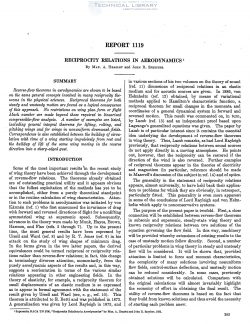naca-report-1119
- Version
- 133 Downloads
- 2.04 MB File Size
- 1 File Count
- October 27, 2016 Create Date
- October 27, 2016 Last Updated
National Advisory Committee for Aeronautics, Report - Reciprocity Relations in Aerodynamics

Reverse-flow theorems in aerodynamics are shown to be based
on the same general concepts involved in many reciprocity the-
orems in the physical sciences. Reciprocal theorems for both
steady and unsteady motion are found as a logical consequence
of this approach. No restrictions on wing pbrn form or flight
Adach number are made beyond those required in linearized
compressible-flow analysis. A number of examples are listed,
including general integral theorems for lifting, rolling, and
pitching wings and for wings in nonuniform downwash fields.
Correspondence is also established between the buildup of circu-
lation with time of a wing starting impulsively from rest and
the buildup of lift of the same wing moving in the reverse
direction into a sharp-edged gust.
Some of the most important resfltshn the recent study
of wing theory have been achieved through the development
of reverse-flow relations. The theorems already obtained
are of outstanding practical utility and it appears obvious
that the fullest exploitation of the methods has yet to be
accomplished, either from a purely theoretical standpoint
or in the routine calculation of wing characteristics.
Attention to such problems in aerodynamics was initiated by von
Karmiin (ref. 1) who first announced the invariance of drag,
with forward and reversed directions of flight for a nonlifting
symmetrical wing at supersonic speed. Subsequently,
advances in the theory Were made by Munk, Hayes, Brown,
Harmon, and Flax (refs. 2 through 7). Up to the present
time, the most general results have been expressed by
Ursell and Ward (ref. 8) and by R. T. Jones (ref. 9) in his
attack on the study of wing shapes of minimum drag.
In the forms given in the two latter papers, the derived
equivalences could be termed reciprocal or reciprocity rela—
tions rather than reverse-flow relations; in fact, this change
in terminology divorces attention, momentarily, from the
purely aerodynamic aspects of the results and, in this way,
suggests a reorientation in terms of the various similar
relations appearing in other engineering fields. In the
theory of elasticity, for example, a reciprocity theorem for
small displacements of an elastic medium is so expressed
as to appear in formal agreement with the statement of the
result given by Ursell and Ward (see, 6. g., ref. 10). This
theorem is attributed to E. Betti and was published in 1872.
| File | Action |
|---|---|
| naca-report-1119 Reciprocity Relations in Aerodynamics.pdf | Download |
Comment On This Post